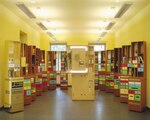Societaetstheater

The Societaetstheater is the oldest popular theatre in Dresden, Germany. Founded in 1776 as an amateur theatre by a society of friends from both the nobility and the middle class, it was initially respected and influential but declined in the early 19th century after the fashion shifted to elaborate historical and verse dramas and the national theatre movement grew in importance, and was eventually dissolved in 1832. The Baroque building on Hauptstraße in the Innere Neustadt was abandoned for many years in the second half of the 20th century, but beginning in 1979, a movement grew to restore it. The theatre reopened in 1999 and is now operated by the city.
Excerpt from the Wikipedia article Societaetstheater (License: CC BY-SA 3.0, Authors, Images).Societaetstheater
An der Dreikönigskirche, Dresden Innere Neustadt (Neustadt)
Geographical coordinates (GPS) Address Phone number Website External links Nearby Places Show on map
Geographical coordinates (GPS)
| Latitude | Longitude |
|---|---|
| N 51.060555555556 ° | E 13.742777777778 ° |
Address
Societätstheater
An der Dreikönigskirche 1a
01097 Dresden, Innere Neustadt (Neustadt)
Saxony, Germany
Open on Google Maps










